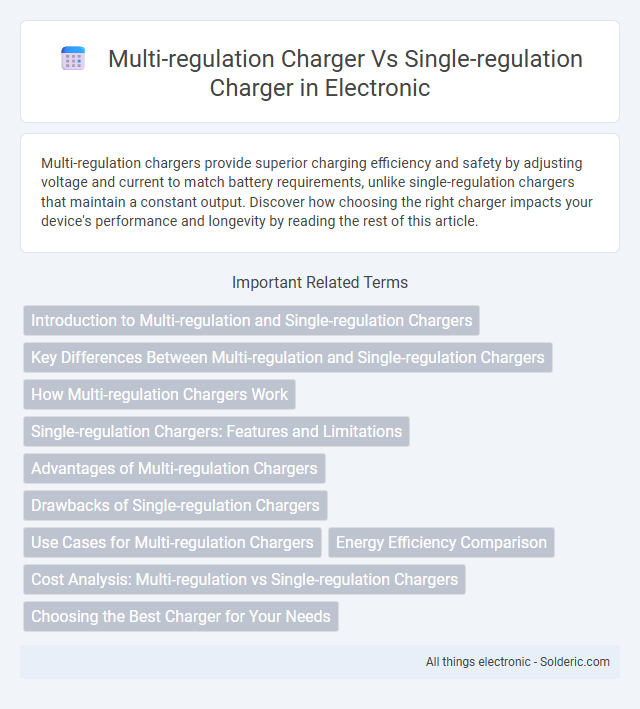Multi-regulation chargers provide superior charging efficiency and safety by adjusting voltage and current to match battery requirements, unlike single-regulation chargers that maintain a constant output. Discover how choosing the right charger impacts your device's performance and longevity by reading the rest of this article.
Comparison Table
| Feature | Multi-regulation Charger | Single-regulation Charger |
|---|---|---|
| Voltage Control | Multiple voltage levels for varied devices | Fixed voltage output |
| Compatibility | Supports diverse battery types and capacities | Designed for one specific battery type |
| Efficiency | Optimizes power delivery across devices | Less efficient with non-matching devices |
| Safety Features | Advanced protections for voltage, current, and temperature | Basic safety mechanisms |
| Cost | Higher initial investment | Lower cost |
| Use Case | Ideal for multi-device users and professionals | Best for single-device or fixed battery setups |
| Size & Portability | Typically larger due to complex circuitry | Compact and lightweight |
Introduction to Multi-regulation and Single-regulation Chargers
Multi-regulation chargers utilize multiple regulation stages to optimize charging efficiency and battery protection by adjusting voltage and current dynamically. Single-regulation chargers maintain a fixed charging parameter, leading to simpler design but less adaptability for various battery types and conditions. The advanced control in multi-regulation chargers enhances battery lifespan and performance compared to traditional single-regulation models.
Key Differences Between Multi-regulation and Single-regulation Chargers
Multi-regulation chargers feature multiple voltage and current settings, allowing for precise control tailored to different battery types and charging needs, whereas single-regulation chargers operate at a fixed voltage or current level. Multi-regulation chargers enhance battery lifespan and safety by adapting to specific requirements, while single-regulation chargers offer simplicity and cost-effectiveness at the expense of versatility. Your choice depends on whether you prioritize advanced customization or straightforward, consistent charging performance.
How Multi-regulation Chargers Work
Multi-regulation chargers use multiple feedback loops to precisely control charging voltage and current, ensuring safe and efficient power delivery to various battery types. These chargers constantly monitor battery conditions and adjust parameters dynamically to prevent overcharging or overheating, enhancing battery lifespan and performance. Your device benefits from faster, more adaptive charging tailored to its specific power requirements.
Single-regulation Chargers: Features and Limitations
Single-regulation chargers maintain a constant voltage output regardless of battery condition, making them simpler but less efficient for diverse battery types. Their primary limitation is the inability to adjust current dynamically, which can lead to overcharging or undercharging risks. These chargers are ideal for basic applications but may reduce battery lifespan due to lack of adaptive charging control.
Advantages of Multi-regulation Chargers
Multi-regulation chargers offer precise voltage and current control, enhancing battery longevity and safety by adapting to different battery chemistries and charging stages. These chargers improve energy efficiency through optimized power delivery, reducing heat generation and electrical waste. Their advanced algorithms enable faster charging times while maintaining protection against overcharging and overheating, outperforming single-regulation chargers in versatility and reliability.
Drawbacks of Single-regulation Chargers
Single-regulation chargers often suffer from inefficiencies, leading to slower charging times and increased energy consumption. They lack adaptability to various battery types and conditions, which can cause overheating, reduced battery lifespan, and potential safety hazards. In contrast, multi-regulation chargers optimize voltage and current dynamically, enhancing performance and battery health.
Use Cases for Multi-regulation Chargers
Multi-regulation chargers excel in applications requiring precise control over voltage and current levels, such as in sensitive electronic devices and rechargeable battery management systems. These chargers adapt dynamically to varying power requirements, ensuring optimal charging efficiency and prolonging battery life. Industries like automotive, telecommunications, and consumer electronics benefit significantly from the versatility and reliability of multi-regulation chargers in diverse operational environments.
Energy Efficiency Comparison
Multi-regulation chargers optimize energy efficiency by dynamically adjusting voltage and current levels according to device requirements, reducing power loss during charging. Single-regulation chargers maintain a constant output regardless of device needs, leading to higher energy consumption and heat generation. Choosing a multi-regulation charger can significantly enhance your device's charging efficiency and reduce electricity usage.
Cost Analysis: Multi-regulation vs Single-regulation Chargers
Multi-regulation chargers typically incur higher initial costs due to complex circuitry and multiple voltage control components compared to single-regulation chargers, which feature simpler designs and lower manufacturing expenses. However, multi-regulation chargers can lead to long-term savings by improving energy efficiency and reducing heat dissipation, minimizing electricity consumption and cooling system requirements. Single-regulation chargers may require frequent maintenance and replacements, potentially increasing operational costs over time despite their lower upfront price.
Choosing the Best Charger for Your Needs
Multi-regulation chargers provide precise voltage and current control, making them ideal for complex battery types and sensitive electronics, while single-regulation chargers offer simplicity and cost-effectiveness for standard charging tasks. Selecting the best charger depends on the specific battery chemistry, charging speed requirements, and the level of safety features needed. For advanced applications requiring tailored charging profiles and enhanced protection, a multi-regulation charger is usually the optimal choice.
Multi-regulation charger vs Single-regulation charger Infographic

 solderic.com
solderic.com